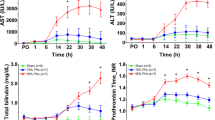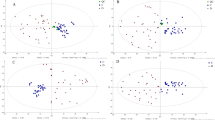Abstract
Fulminant hepatic failure (FHF) is still an intractable disease associated with serious metabolic disorder. Investigating the dynamic changes of serum metabolites during the development of FHF would facilitate revealing the pathogenesis and also promote its treatment. Therefore, this study characterized the dynamic metabonome of serum from FHF Pigs using ultra performance liquid chromatography–mass spectrometry. Based on multiple statistical analysis of the resulting dataset, three types of up-regulated and one type of down-regulated patterns were delineated. Each pattern demonstrated distinct trends at different stages during the whole process of FHF, implying the differential clinical significance of them. Specifically, aromatic amino acids (Pattern 1) and lysophosphatidylcholines (LPCs) (Pattern 4) might be good markers for evaluating the severity of FHF, while some conjugated bile acids, long chain acylcarnitines (Pattern 2) and Glycocholic acid (Pattern 3) could indicate liver injury in the early stage. Inspired from the PCA plot that the pathogenetic condition of FHF aggravated with sampling time, a linear discriminant analysis (LDA) model based on phenylalanine and LPC 18:1 were further constructed for evaluating the severity of FHF. The leave-one-out cross-validation accuracy of 91.67% for the training set and the prediction accuracy of 92.31% for the external validation set confirmed its excellent performance. In conclusion, findings obtained from the present study, including four types of Dynamic Patterns of serum metabolites during FHF development and an LDA model for evaluating the severity of FHF, will be of great help to the research and management of FHF in the future.





Similar content being viewed by others
Abbreviations
- AAA:
-
Aromatic amino acids
- AASLD:
-
The American Association for the Study of Liver Diseases
- ALT:
-
Aspartate aminotransferase
- BPI:
-
Base peak intensity
- CHO:
-
Cholesterol
- CV:
-
Coefficient of variation
- d-gal:
-
d-galactosamine
- FHF:
-
Fulminant hepatic failure
- GC–MS:
-
Gas chromatography–mass spectrometry
- GCDCA:
-
Chenodeoxycholic acid glycine conjugate
- GUDCA:
-
Glycoursodeoxycholic acid
- HPLC–MS:
-
High performance liquid chromatography–mass spectrometry
- LDA:
-
Linear discriminant analysis
- LOOCV:
-
Leave-one-out cross-validation
- LPCs:
-
Lysophosphatidylcholines
- MELD:
-
The model for end-stage liver disease
- PCA:
-
Principal components analysis
- PLS-DA:
-
Partial least squares discriminate analysis
- PTA:
-
Prothrombin time activity
- QC:
-
Quality control
- TB:
-
Total bilirubin
- TBA:
-
Total bile acids
- UPLC–MS:
-
Ultra performance liquid chromatography–mass spectrometry
- VIP:
-
Variable importance in the projection
References
Antoniades, C. G., Berry, P. A., Wendon, J. A., & Vergani, D. (2008). The importance of immune dysfunction in determining outcome in acute liver failure. Journal of Hepatology, 49, 845–861.
Benz, C., Angermuller, S., Tox, U., et al. (1998). Effect of tauroursodeoxycholic acid on bile-acid-induced apoptosis and cytolysis in rat hepatocytes. Journal of Hepatology, 28, 99–106.
Bernal, W., Auzinger, G., Dhawan, A., & Wendon, J. (2010). Acute liver failure. Lancet, 376, 190–201.
Churchwell, M. I., Twaddle, N. C., Meeker, L. R., & Doerge, D. R. (2005). Improving LC-MS sensitivity through increases in chromatographic performance: comparisons of UPLC-ES/MS/MS to HPLC-ES/MS/MS. Journal of Chromatography B. Analytical Technologies in the Biomedical and Life Sciences, 825, 134–143.
Douglas, W. R. (1972). Of pigs and men and research: a review of applications and analogies of the pig, sus scrofa, in human medical research. Space Life Sciences, 3, 226–234.
Feng, B., Wu, S., Lv, S., et al. (2007). Metabolic profiling analysis of a D-galactosamine/lipopolysaccharide-induced mouse model of fulminant hepatic failure. Journal of Proteome Research, 6, 2161–2167.
Feng, B., Wu, S., Lv, S., et al. (2008). Dynamic metabonomic analysis of BALB/c mice with different outcomes after D-galactosamine/lipopolysaccharide-induced fulminant hepatic failure. Liver Transplantation, 14, 1620–1631.
Gao, Y. Y., Han, T., & Kan, Z. C. (2009). Clinical study of survival time for chronic liver failure. Zhonghua Gan Zang Bing Za Zhi, 17, 131–134.
Hao, S., Xin, J., Lian, J., & Li, L. (2011). Establishing a metabolomic model for the prognosis of hepatitis B virus-induced acute-on-chronic liver failure treated with different liver support systems. Metablomics, 7, 400–412.
Hofmann, A. F., Korman, M. G., & Krugman, S. (1974). Sensitivity of serum bile acid assay for detection of liver damage in viral hepatitis type B. Prospective study in five patients. American Journal of Digestive Diseases, 19, 908–910.
Li, L. J., Wu, Z. W., Xiao, D. S., & Sheng, J. F. (2004). Changes of gut flora and endotoxin in rats with D-galactosamine-induced acute liver failure. World Journal of Gastroenterology, 10, 2087–2090.
Lingens, F. (1968). The biosynthesis of aromatic amino acids and its regulation. Angewandte Chemie (International ed. in English), 7, 350–360.
Lv, G., Zhao, L., Zhang, A., et al. (2011). Bioartificial liver system based on choanoid fluidized bed bioreactor improve the survival time of fulminant hepatic failure pigs. Biotechnology and Bioengineering, 9, 2229–2236.
Malhi, H., Gores, G. J., & Lemasters, J. J. (2006). Apoptosis and necrosis in the liver: a tale of two deaths? Hepatology, 43, S31–S44.
Mao, Y., Huang, X., Yu, K., et al. (2008). Metabonomic analysis of hepatitis B virus-induced liver failure: identification of potential diagnostic biomarkers by fuzzy support vector machine. Journal of Zhejiang University-Science B, 9, 474–481.
Mutomba, M. C., Yuan, H., Konyavko, M., et al. (2000). Regulation of the activity of caspases by L-carnitine and palmitoylcarnitine. FEBS Letters, 478, 19–25.
Nicholson, J. K., & Lindon, J. C. (2008). Systems biology: Metabonomics. Nature, 455, 1054–1056.
Olofsson, K. E., Andersson, L., Nilsson, J., & Bjorkbacka, H. (2008). Nanomolar concentrations of lysophosphatidylcholine recruit monocytes and induce pro-inflammatory cytokine production in macrophages. Biochemical and Biophysical Research Communications, 370, 348–352.
Pennington, C. R., Ross, P. E., & Bouchier, I. A. (1977). Serum bile acids in the diagnosis of hepatobiliary disease. Gut, 18, 903–908.
Polson, J., & Lee, W. M. (2005). AASLD position paper: the management of acute liver failure. Hepatology, 41, 1179–1197.
Radu, C. G., Yang, L. V., Riedinger, M., Au, M., & Witte, O. N. (2004). T cell chemotaxis to lysophosphatidylcholine through the G2A receptor. Proceedings of the National Academy of Sciences USA, 101, 245–250.
Sass, D. A., & Shakil, A. O. (2005). Fulminant hepatic failure. Liver Transplantation, 11, 594–605.
Silk, D. B. (1986). Branched chain amino acids in liver disease: Fact or fantasy? Gut, 27(Suppl 1), 103–110.
Smith, A. R., Rossi-Fanelli, F., Ziparo, V., et al. (1978). Alterations in plasma and CSF amino acids, amines and metabolites in hepatic coma. Annals of Surgery, 187, 343–350.
Want, E. J., Wilson, I. D., Gika, H., et al. (2010). Global metabolic profiling procedures for urine using UPLC–MS. Nature Protocols, 5, 1005–1018.
Yang, J., Zhao, X., Liu, X., et al. (2006). High performance liquid chromatography–mass spectrometry for metabonomics: potential biomarkers for acute deterioration of liver function in chronic hepatitis B. Journal of Proteome Research, 5, 554–561.
Yu, K., Sheng, G., Sheng, J., et al. (2007). A metabonomic investigation on the biochemical perturbation in liver failure patients caused by hepatitis B virus. Journal of Proteome Research, 6, 2413–2419.
Zhang, L., Jia, X., Peng, X., et al. (2010). Development and validation of a liquid chromatography–mass spectrometry metabonomic platform in human plasma of liver failure caused by hepatitis B virus. Acta Biochimica et Biophysica Sinica (Shanghai), 42, 688–698.
Acknowledgments
The work was financially supported by National High Technology Research and Development Program of China (863 Program, No. 2011AA020104), National S&T Major Project for Infectious Disease Control of China (No. 2008ZX10002-05), and Science Fund for Creative Research Groups of the National Natural Science Foundation of China (NO. 81121002).
Author information
Authors and Affiliations
Corresponding author
Electronic supplementary material
Below is the link to the electronic supplementary material.
11306_2011_381_MOESM9_ESM.tif
MS/MS identification of linoleylcarnitine based on its retention time and the characteristic ion fragments (m/z = 85) of long-chain acylcarnitines (TIFF 354 kb)
11306_2011_381_MOESM10_ESM.tif
MS/MS identification of elaidic carnitine based on its retention time and the characteristic ion fragments (m/z = 85) of long-chain acylcarnitines (TIFF 316 kb)
11306_2011_381_MOESM14_ESM.tif
MS/MS identification of LPC 18:1 based on its retention time and the characteristic ion fragments (m/z = 184 and m/z = 104) of lysophosphatidylcholines (TIFF 376 kb)
11306_2011_381_MOESM15_ESM.tif
MS/MS identification of LPC 18:2 based on its retention time and the characteristic ion fragments (m/z = 184 and m/z = 104) of lysophosphatidylcholines (TIFF 338 kb)
11306_2011_381_MOESM16_ESM.tif
MS/MS identification of LPC 20:4 based on its retention time and the characteristic ion fragments (m/z = 184 and m/z = 104) of lysophosphatidylcholines (TIFF 401 kb)
Rights and permissions
About this article
Cite this article
Zhou, P., Li, J., Shao, L. et al. Dynamic Patterns of serum metabolites in fulminant hepatic failure pigs. Metabolomics 8, 869–879 (2012). https://doi.org/10.1007/s11306-011-0381-5
Received:
Accepted:
Published:
Issue Date:
DOI: https://doi.org/10.1007/s11306-011-0381-5




